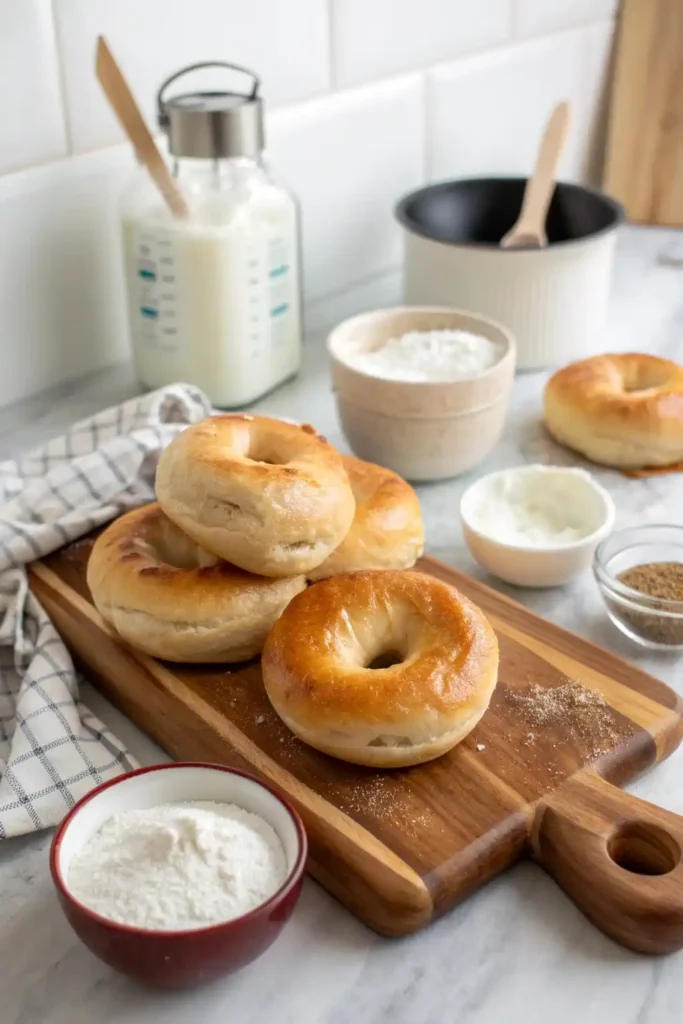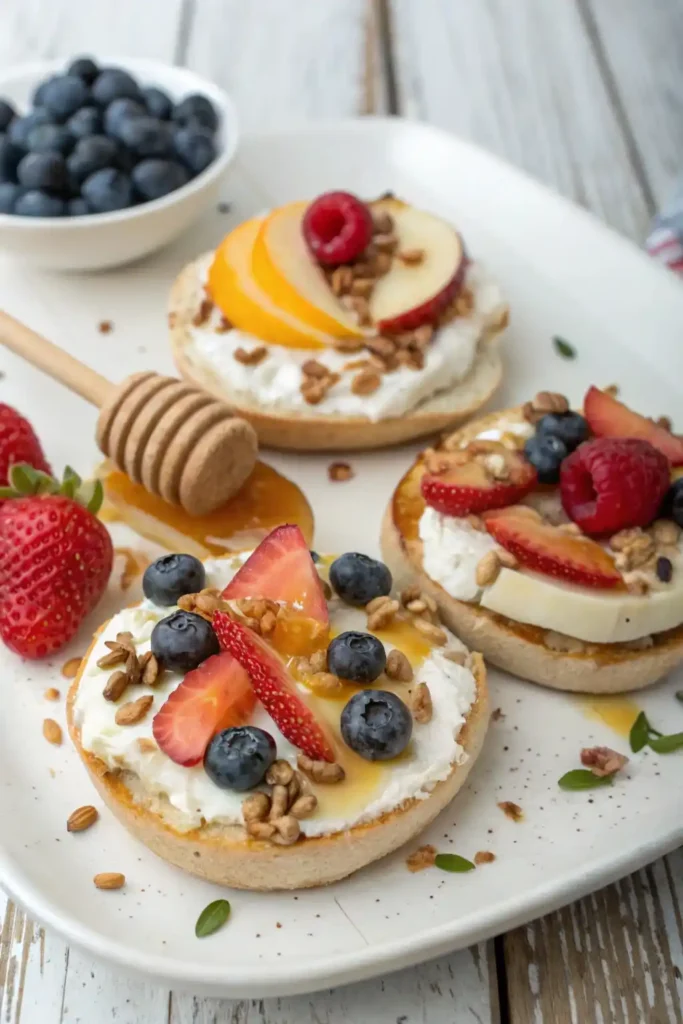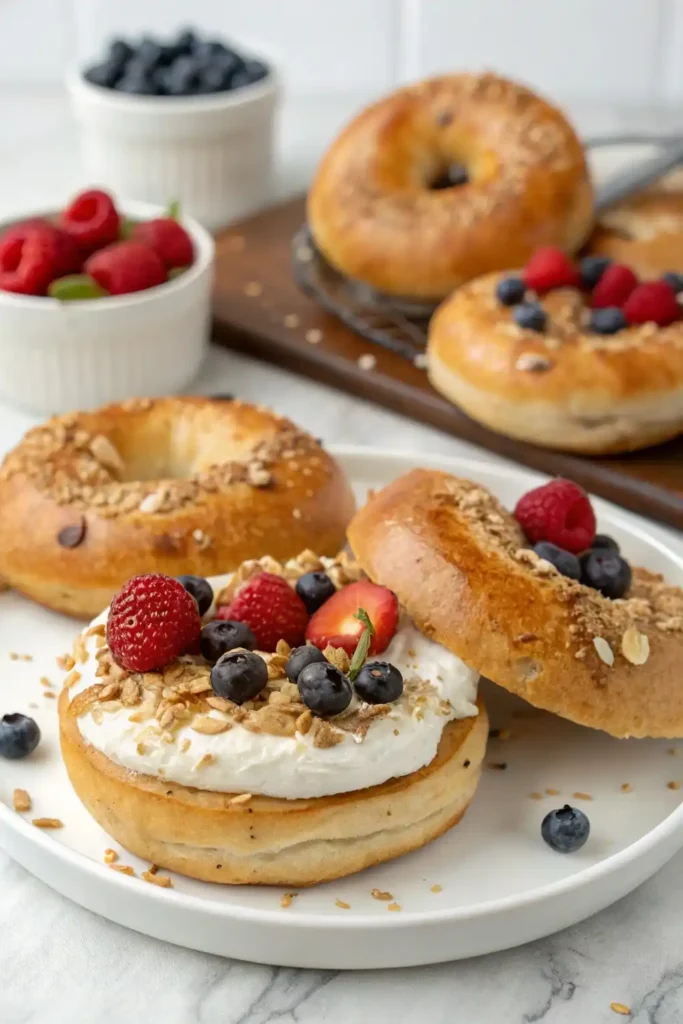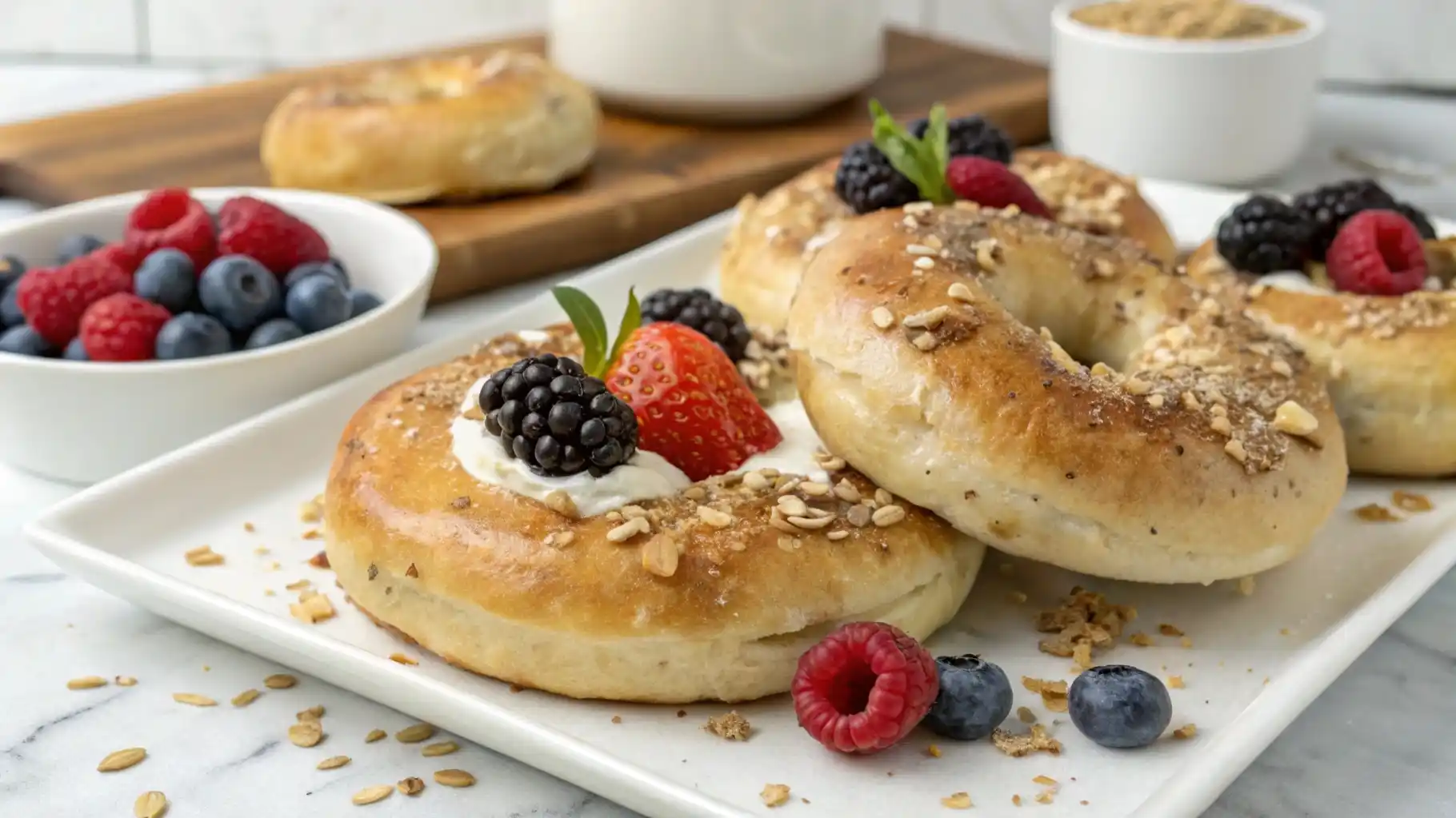A homemade protein bagel can pack over 13 grams of protein into each delicious serving – hard to believe, right?
These amazing Greek yogurt bagels need just 5 simple ingredients and come together in under 30 minutes. You won’t need any yeast, fancy equipment, or complex boiling techniques. The bagels have nowhere near the carbs and fats of traditional ones, yet they still give you that perfect chewy texture you love.
The recipe makes an excellent choice for weekly meal prep or a protein-rich breakfast option. Let us guide you through each step of making these protein-packed bagels with Greek yogurt. We’ll cover everything from dough preparation to topping selection to help you create the perfect batch.
Table of Contents
Why Greek Yogurt Makes Perfect Protein Bagels

Greek yogurt is the life-blood ingredient that makes protein-rich bagels better than traditional recipes in nutrition and texture. Here’s the science and benefits of this versatile ingredient.
The Science Behind Greek Yogurt in Baking
Greek yogurt’s unique makeup changes how baking works. Regular yogurt becomes Greek yogurt through careful straining that removes whey and other liquids. This concentrated form creates a thicker, denser product that will affect baking chemistry. The acidic properties in Greek yogurt work with baking soda to create the perfect rise and texture in baked goods.
Greek yogurt’s protein-rich structure helps create stronger gluten networks in bagel dough. The dough becomes more stable and holds its shape better during baking. Straining also cuts down lactose content, which naturally reduces sugar levels while keeping proteins intact.
Protein Content Comparison
Greek yogurt bagels stand out from regular recipes because of their protein content. Each bagel packs 11-15 grams of protein, which is much higher than traditional bagels. Greek yogurt contains double the protein of regular yogurt, which boosts these bagels’ nutritional value.
These bagels are a great way to get specific protein amounts. The protein content changes based on your choice of Greek yogurt:
- Full-fat Greek yogurt provides richer texture
- Low-fat options maintain high protein levels
- Non-fat varieties often contain more protein due to concentrated milk solids
Texture and Flavor Benefits
Greek yogurt creates amazing bagel texture. The dough starts perfectly moist and bakes into a soft, fluffy interior while keeping that classic chewy bagel exterior. Greek yogurt’s thickness also creates a denser, more satisfying crumb structure.
The flavor has a subtle tanginess that reminds you of sourdough. This unique taste comes from natural fermentation, which adds depth without overwhelming the bagel’s simple character. Greek yogurt’s creamy consistency spreads moisture evenly throughout the dough.
The final texture depends on several factors:
- Protein concentration creates a tighter, more uniform crumb
- Natural acidity helps proper gluten development
- Less moisture than regular yogurt prevents overly wet dough
Greek yogurt does more than just work well in this recipe. You can use it instead of sour cream or buttermilk, while getting more protein and less fat. The mix of flour and Greek yogurt creates perfectly shaped bagels with great consistency every time.
Essential Ingredients for High Protein Bagels

Perfect protein bagels start with the right ingredients. Each component plays a specific role that leads to consistent results.
Choosing the Right Greek Yogurt
Greek yogurt’s thickness and fat content will affect your bagel’s texture. Full-fat Greek yogurt (5% or 2%) makes softer dough and creates richer-tasting bagels. Fage brand excels because it offers consistently thick texture. You can also use 0% Greek yogurt that works well if you want a lower-fat option.
You’ll get the best results when you:
- Drain any excess liquid before using
- Select thick, strained varieties
- Think about fat content based on desired texture
Flour Options and Protein Content
Your choice of flour shapes both protein content and texture. Bread flour contains about 13.5% protein and creates chewier bagels with better structure. All-purpose flour gives you softer bagels, while high-gluten flour delivers that characteristic chewy texture bagel lovers want.
Different dietary needs can be met with these flour alternatives:
- Self-rising flour (omit salt and baking powder)
- Gluten-free flour blends (like Bob’s Red Mill 1-to-1)
- Whole wheat flour (may need extra moisture)
Optional Add-ins for Extra Protein
You can boost protein content naturally beyond the simple ingredients. To name just one example, see vital wheat gluten – just ¼ cup (30g) adds an impressive 23g of plant protein. Cottage cheese works great as a protein booster, especially when you have Greek yogurt in the mix.
These toppings add variety without reducing protein content:
- Everything bagel seasoning
- Dehydrated garlic or onion flakes
- Sesame or poppy seeds
- Grated cheese for savory versions
The simple recipe needs just five core ingredients:
- Greek yogurt (strained)
- Flour of choice
- Baking powder
- Salt
- Egg white (optional, for structure)
Silken tofu can replace Greek yogurt in equal amounts if you need dairy alternatives. Whatever substitutions you make, proper ingredient ratios are vital to achieve the right texture and protein content.
Room temperature Greek yogurt blends more smoothly with dry ingredients and creates more uniform dough. Take the yogurt out of the refrigerator 15-20 minutes before you start making bagels.
Step-by-Step Protein Bagel Recipe
Becoming skilled at making protein bagels starts with the right techniques that lead to perfect results. Let’s take a closer look at how to create these nutritious treats step by step.
Preparing the Dough
Preheat your oven to 375°F. Mix the flour, baking powder, and salt in a medium bowl and whisk them really well until they blend together. The next step adds Greek yogurt to create your protein-rich dough’s foundation.
Use a fork or spatula to mix everything until you see small crumbles forming. The mixture might seem too dry at first, but it will come together once you start kneading with clean hands. You’ll need to knead for about 2 minutes until the dough feels tacky without sticking – your hands should stay clean.

Shaping Perfect Bagels
The prepared dough should be split into 4 equal parts. Each part should weigh around 80 grams to get it right. You can shape your bagels using two tested methods:
Method 1 – Rope Technique:
- Roll each part into a 6-8 inch rope
- Connect the ends to make a circle
- Roll the seam against the counter to seal it properly
Method 2 – Center Hole Approach:
- Shape the dough into a ball
- Push your thumb through the middle
- Stretch gently until you have a 2-inch diameter hole
The next vital step is brushing the bagels with egg wash. This will help your toppings stick and give you that beautiful golden-brown finish.
Baking vs. Air Frying Methods
You’ll get great results with both baking and air frying, but each needs specific timing and temperature settings.
Oven Baking Instructions:
- Put the rack at the top of your oven
- Set bagels on a parchment-lined baking sheet
- Bake at 375°F for 25 minutes
- Let them cool for 15 minutes before cutting
Air Fryer Specifications:
- Heat your air fryer to 280°F
- Cook in batches with enough space
- Air fry for 15-16 minutes until golden
- No need to flip them
Space your bagels properly as they’ll grow while cooking. Your bagels need that cooling time – skipping it could ruin their texture and shape.
Air frying takes less time and browns more evenly. Oven baking lets you make more bagels at once.
These protein bagels stay fresh for up to 3 days when wrapped in plastic at room temperature. You can also slice and freeze them individually wrapped, then warm them up in your oven or air fryer.
Troubleshooting Common Bagel Problems
Making protein bagels with Greek yogurt can challenge even seasoned bakers. Let’s look at common problems and their solutions to help you get perfect results every time.
Fixing Sticky Dough
Your dough might get sticky because different Greek yogurt brands have varying whey content. Here’s how to fix it:
- Add flour bit by bit until the dough barely sticks to your hands
- Knead the dough about 15 times to mix the flour well
- Skip regular yogurt – it has too much moisture and makes the dough hard to handle
Non-fat Greek yogurt works best and reduces stickiness. You can also dust your hands with flour instead of the counter to keep the right dough texture.
Preventing Dense Bagels
Dense bagels happen because of several reasons that affect how your dough develops. The right gluten formation is vital – without enough gluten, your bagels won’t rise well and will have a rough surface.
Here’s how to avoid dense bagels:
- Don’t overwork the dough or it won’t expand properly
- Watch your proofing time – under-proofed dough makes ball-like bagels
- Keep your water bubbling hot while boiling each batch
Gluten-free bakers face special challenges since their flour lacks natural gluten. So make shorter logs and smaller holes in the center to make up for less stretch and rise.
Solutions for Bagels That Won’t Rise
Bagels might not rise well for several reasons. Very dense dough can block gasses from moving through the structure.
Your bagels might not rise because of:
- Wrong flour measurements – weighing works better than measuring by volume
- Incorrect flour type – use bread flour with about 12% protein content
- Dead yeast – keep salt away from direct contact with yeast
These steps will help your bagels rise:
- Give dough a 10-minute rest before shaping
- Wait until shaped bagels double in size
- Let fresh-baked bagels sit for 15 minutes before cutting
Sometimes bagels rise well but fall flat during boiling or baking. This usually happens from fermenting too long, which turns starch into sugar. The dough structure gets weak and collapses despite looking puffy at first.
The cooling process matters as much as baking. Cutting hot bagels right after baking leaves you with gummy centers. Let them cool completely to get the right texture throughout.
Storing and Freezing Your Greek Yogurt Bagels

Your homemade protein bagels will taste better and keep their texture when you store them right. The right cooling and freezing methods help preserve their nutrients and make them last longer.
Proper Cooling Techniques
The right cooling process gives your bagels the best texture. Let them sit on the baking pan for 15-20 minutes after taking them out of the oven. This step keeps the inside from getting too soft or gummy.
Make sure air can flow around each bagel while they cool. These protein-packed treats will develop their signature chewy texture and keep their crispy outside once they cool completely.
Freezing Methods for Meal Prep
Freezing works great if you want to store bagels longer. Your homemade bagels stay fresh in the freezer up to 3 months. You have several storage options based on when you’ll eat them:
Room Temperature Storage:Keep cooled bagels in an airtight container at room temperature for 2-3 days. This works best if you plan to eat them soon.
Refrigerator Storage:The fridge keeps your bagels fresh up to one week. This option is perfect for weekly meal prep.
Freezer Preparation Steps:
- Let bagels cool completely
- Cut each bagel in half
- Wrap each one in plastic wrap or parchment paper
- Put wrapped bagels in a freezer-safe bag
Reheating for Best Texture
You’ll need different techniques to reheat your bagels depending on whether they’re frozen or thawed.
From Thawed State:
- Let thaw overnight in refrigerator
- Heat oven to 350°F
- Heat for 10-12 minutes
- Let cool 5-10 minutes
From Frozen State:
- Heat oven to 300°F
- Wrap bagel in foil
- Heat for 30 minutes
- Take off foil
- Bake 10 more minutes at 375°F
A toaster works quickly for both thawed and frozen bagels. Just adjust your toaster settings – the “bagel setting” gives the best results.
These storage methods help meal preppers keep their Greek yogurt protein bagels fresh all week. Good storage techniques keep the taste and nutrients intact, which makes these protein-rich bagels perfect for busy people.
Bagels taste best on day one when kept at room temperature, but good reheating brings back their original texture. Freezing individual portions helps maintain quality over time.
Conclusion
Greek yogurt bagels are the perfect choice if you want protein-rich homemade bread. Each bagel packs over 13 grams of protein and gives you that classic chewy texture everyone loves.
You’ll only need 5 simple ingredients and basic kitchen tools to make these protein-packed treats. The recipe works great whether you bake them in the oven or use an air fryer. Both methods give excellent results when you nail the timing and technique.
Quality ingredients make all the difference in your bagels, especially thick Greek yogurt. Let them cool completely before you store them. You can freeze individual portions to make meal prep easier.
These protein bagels work with countless toppings and add-ins without losing their nutritional punch. On top of that, you can easily fix common problems once you understand what makes the dough consistency and baking techniques work.
Want more healthy and delicious recipes? Check out recipesnutritious.com for amazing meal ideas that taste great and keep you healthy. A bit of practice and patience will help you become skilled at making these protein-rich bagels that’ll become your breakfast staple.
FAQs
Q1. How many calories and grams of protein are in these Greek yogurt bagels? Each Greek yogurt bagel contains approximately 150-160 calories and 10-13 grams of protein, making them a nutritious and satisfying option for those looking to increase their protein intake.
Q2. Can I freeze these homemade protein bagels? Yes, you can freeze these bagels for up to 3 months. Allow them to cool completely, slice in half, wrap individually in plastic wrap or parchment paper, and store in a freezer-safe bag. Thaw overnight in the refrigerator before reheating.
Q3. What’s the best way to reheat frozen Greek yogurt bagels? For best results, preheat your oven to 350°F and heat thawed bagels for 10-12 minutes. If reheating from frozen, wrap the bagel in foil and heat at 300°F for 30 minutes, then remove the foil and bake for an additional 10 minutes at 375°F.
Q4. Can I make sweet versions of these protein bagels? Absolutely! You can add ingredients like cinnamon, raisins, or a sprinkle of sugar substitute to create sweet variations. Just be mindful that additions may slightly alter the calorie and macronutrient content.
Q5. How do these Greek yogurt bagels compare to traditional bagels in terms of texture? While not identical to traditional yeast-based bagels, these Greek yogurt bagels offer a satisfying chewy texture with a crisp exterior when properly baked. They have a fluffy interior and, when toasted, closely mimic the texture of conventional bagels.

